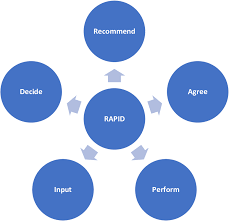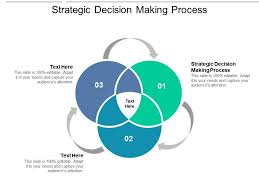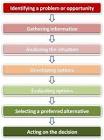Strategic Management Decision-Making Process: A Guide to Effective Decision Making
Effective decision making is crucial for the success of any organization, especially when it comes to strategic management. Strategic decisions shape the future direction of a company and have a significant impact on its long-term performance. In this article, we will explore the strategic management decision-making process and provide a guide to help organizations make informed and effective decisions.
Identify the Problem or Opportunity:
The first step in the strategic management decision-making process is to identify the problem or opportunity that requires a decision. This could be a challenge faced by the organization or an emerging market opportunity that needs to be capitalized on. It is important to clearly define and understand the issue at hand before proceeding further.
Gather Relevant Information:
Once the problem or opportunity is identified, it is essential to gather all relevant information related to it. This includes conducting market research, analyzing industry trends, evaluating internal capabilities, and considering any potential risks or constraints. The more comprehensive and accurate the information gathered, the better equipped decision-makers will be in making informed choices.
Generate Alternatives:
In this stage, decision-makers should generate multiple alternatives that could potentially address the identified problem or leverage the opportunity at hand. It is important to encourage creative thinking and consider various options that align with organizational goals and objectives. Each alternative should be evaluated based on its feasibility, potential outcomes, risks involved, and alignment with organizational values.
Evaluate Alternatives:
After generating alternatives, it’s time to evaluate them based on predetermined criteria. These criteria may include factors such as cost-effectiveness, sustainability, competitive advantage, resource allocation requirements, and potential impact on stakeholders. By objectively assessing each alternative against these criteria, decision-makers can narrow down their options and identify those with the highest potential for success.
Make a Decision:
Once all alternatives have been thoroughly evaluated, it’s time to make a decision based on the available information and analysis. This decision should be aligned with the organization’s vision, mission, and strategic goals. It is important to consider the potential short-term and long-term implications of the decision, as well as any trade-offs that may need to be made.
Implement the Decision:
Implementing a strategic decision requires careful planning and execution. This involves allocating resources, assigning responsibilities, setting timelines, and establishing key performance indicators to track progress. Effective communication is crucial during this stage to ensure that all stakeholders are aware of the decision and understand their roles in its implementation.
Monitor and Evaluate:
Once the decision has been implemented, it is essential to monitor its progress and evaluate its effectiveness. Regular monitoring allows for adjustments to be made if necessary, ensuring that the decision remains aligned with changing circumstances. Evaluation should focus on measuring outcomes against predetermined goals and objectives, as well as learning from any mistakes or successes encountered along the way.
In conclusion, effective strategic management decision making is a critical process for organizations aiming for long-term success. By following a structured approach that includes problem identification, information gathering, alternative generation and evaluation, decision-making, implementation, and ongoing monitoring and evaluation, organizations can make informed choices that align with their strategic goals. Remember that effective decision making requires a balance between analysis and intuition while considering both internal capabilities and external market dynamics.
5 Essential Tips for Effective Strategic Management Decision Making Process
- Develop a clear strategy
- Analyze the current situation
- Gather input from stakeholders
- Make data-driven decisions
- Monitor progress regularly
Develop a clear strategy
Develop a Clear Strategy: The Key to Successful Strategic Management Decision Making
In the realm of strategic management decision making, developing a clear strategy is an essential step that cannot be overlooked. A well-defined strategy serves as a roadmap for organizations, guiding them towards their desired goals and objectives. It provides a framework for decision making, ensuring that all actions taken align with the overall direction of the organization. In this article, we will explore the importance of developing a clear strategy and how it contributes to successful decision making.
A clear strategy acts as a compass, helping organizations navigate through complex business environments. It provides a sense of purpose and direction, enabling decision-makers to make choices that are in line with the organization’s vision and mission. When there is clarity in strategy, it becomes easier to prioritize initiatives and allocate resources effectively.
One of the primary benefits of having a clear strategy is that it helps in setting specific goals and objectives. These goals provide clarity on what the organization aims to achieve within a defined timeframe. With clearly defined goals, decision-makers can evaluate potential alternatives based on their alignment with these objectives. This enables them to make informed decisions that contribute directly to the achievement of strategic targets.
Furthermore, a clear strategy facilitates effective communication within an organization. When everyone is aware of the overarching strategy, they can align their efforts towards common goals. This shared understanding fosters collaboration and coordination among different departments or teams, ensuring that decisions are made collectively and in harmony with the strategic direction.
Developing a clear strategy also helps organizations anticipate future challenges and opportunities. By conducting thorough analysis and forecasting market trends, decision-makers can identify potential risks or emerging opportunities early on. This proactive approach allows organizations to adapt quickly and make timely decisions that give them a competitive edge.
In addition to these benefits, having a clear strategy enables organizations to monitor progress effectively. By defining key performance indicators (KPIs) aligned with strategic objectives, decision-makers can track performance and make data-driven decisions. Regular monitoring allows for adjustments to be made if necessary, ensuring that the organization stays on track towards its strategic goals.
In conclusion, developing a clear strategy is a crucial aspect of successful strategic management decision making. It provides organizations with a sense of purpose, sets specific goals, facilitates effective communication, enables proactive decision making, and ensures progress is monitored effectively. By investing time and effort into crafting a clear strategy, organizations can enhance their decision-making process and increase their chances of achieving long-term success.
Analyze the current situation
Analyzing the Current Situation: A Key Step in Strategic Management Decision Making
In the complex world of strategic management, making informed decisions is crucial for the success and sustainability of any organization. One essential step in this process is analyzing the current situation. By thoroughly understanding the present state of affairs, decision-makers can gain valuable insights that will inform their strategic choices and drive future success.
Analyzing the current situation involves a comprehensive assessment of both internal and external factors that impact the organization. This step provides decision-makers with a clear understanding of their organization’s strengths, weaknesses, opportunities, and threats (SWOT analysis). It allows them to identify areas for improvement, potential risks, and emerging market trends that could shape their strategic direction.
Internally, analyzing the current situation involves evaluating various aspects such as organizational structure, resources, capabilities, and culture. This assessment helps decision-makers understand what the organization does well and where it may be falling short. It highlights areas where improvements can be made or resources reallocated to achieve better outcomes.
Externally, decision-makers need to analyze factors such as market dynamics, industry trends, customer preferences, competitive landscape, regulatory environment, and technological advancements. This external analysis provides valuable insights into emerging opportunities or potential threats that may impact the organization’s future performance. By staying abreast of these external factors, decision-makers can proactively adapt their strategies to maintain a competitive edge.
During the analysis phase, decision-makers should gather relevant data from reliable sources such as market research reports, financial statements, industry publications, customer feedback surveys, and competitor analysis. They should also engage with stakeholders at various levels within the organization to gain different perspectives on its current state.
Once all relevant information has been gathered and analyzed thoroughly comes the crucial task of interpreting this data accurately. Decision-makers must identify patterns or trends that are likely to impact their strategic decisions positively or negatively. This interpretation helps them make sense of complex information and guides them towards making well-informed choices.
Analyzing the current situation is not a one-time exercise. It should be an ongoing process that occurs regularly to stay attuned to the ever-changing business landscape. By continuously monitoring and evaluating the internal and external factors, decision-makers can make timely adjustments to their strategies as needed.
In conclusion, analyzing the current situation is a vital step in strategic management decision-making. It provides decision-makers with a holistic view of their organization’s internal capabilities and external environment. Armed with this knowledge, they can make informed choices that align with their goals, address challenges, seize opportunities, and position their organization for long-term success.
Gather input from stakeholders
One crucial tip for effective strategic management decision making is to gather input from stakeholders. Stakeholders are individuals or groups who have a vested interest in the organization and can be affected by the decisions made. This can include employees, customers, suppliers, investors, and even the community at large.
Why is gathering input from stakeholders important? First and foremost, it ensures that decisions are not made in isolation but take into account the perspectives and concerns of those who will be impacted. By involving stakeholders in the decision-making process, organizations gain valuable insights, diverse perspectives, and a deeper understanding of the potential consequences of their choices.
Stakeholders often possess unique knowledge and expertise that can contribute to better decision making. Employees, for example, have firsthand experience and insights into operational challenges or customer preferences. Customers can provide feedback on products or services that can shape strategic directions. Suppliers may offer insights into market trends or emerging technologies. By tapping into this collective wisdom, organizations can make more informed decisions that are more likely to succeed.
Moreover, involving stakeholders creates a sense of ownership and buy-in for the decisions made. When individuals feel heard and valued, they are more likely to support and actively contribute to implementing those decisions. This helps foster a culture of collaboration and engagement within the organization.
However, it’s important to note that gathering input from stakeholders does not mean blindly following every suggestion or opinion expressed. The role of decision-makers is to carefully consider all input alongside other factors such as organizational goals, financial viability, legal requirements, and industry trends. The ultimate decision should still align with the organization’s strategic objectives while balancing conflicting interests.
To effectively gather stakeholder input, organizations can employ various methods such as surveys, focus groups, interviews, town hall meetings, or online platforms for feedback submission. It’s essential to ensure transparency throughout the process by clearly communicating how stakeholder input will be considered and how decisions will be made.
In conclusion, gathering input from stakeholders is a vital aspect of strategic management decision making. By involving those who are impacted by decisions, organizations gain valuable insights, foster collaboration, and increase the chances of making informed and successful choices. Remember, stakeholder input should be seen as a valuable resource to enhance decision making rather than a hurdle to overcome.
Make data-driven decisions
Make Data-Driven Decisions: The Key to Strategic Management Success
In today’s fast-paced business environment, making strategic decisions based on gut feelings or intuition alone is no longer enough. To ensure success and stay ahead of the competition, organizations must embrace a data-driven approach to decision making. By leveraging the power of data and analytics, businesses can make informed and objective choices that drive growth and profitability.
Data-driven decision making involves collecting, analyzing, and interpreting relevant data to gain insights into various aspects of the business. This could include customer behavior, market trends, financial performance, operational efficiency, and more. By relying on concrete facts rather than assumptions or personal biases, organizations can make more accurate predictions and identify opportunities or risks that may have otherwise gone unnoticed.
One of the key benefits of data-driven decision making is its ability to reduce uncertainty. By examining historical data and patterns, organizations can gain a deeper understanding of what has worked in the past and what hasn’t. This knowledge allows decision-makers to identify successful strategies and replicate them while avoiding mistakes that may have been made previously.
Moreover, data-driven decision making enables organizations to be proactive rather than reactive. By continuously monitoring key metrics and indicators, businesses can detect early warning signs of potential issues or spot emerging trends in the market. Armed with this information, decision-makers can take timely action to capitalize on opportunities or mitigate risks before they escalate.
Another advantage of a data-driven approach is its ability to foster collaboration within an organization. When decisions are based on objective data rather than personal opinions or hierarchies, it encourages open discussions among team members. Everyone can contribute their insights based on the available data, leading to more inclusive decision-making processes that consider diverse perspectives.
However, it’s important to note that being data-driven does not mean disregarding human judgment altogether. Data should be seen as a tool that informs decisions rather than dictating them entirely. Combining quantitative analysis with qualitative insights and experience can lead to more comprehensive and well-rounded decision making.
In conclusion, embracing a data-driven approach to decision making is crucial for organizations seeking long-term success in today’s competitive landscape. By leveraging the power of data and analytics, businesses can make informed, proactive, and collaborative decisions that drive growth, improve operational efficiency, and enhance customer satisfaction. So, let data be your guide as you navigate the complexities of strategic management and unlock new opportunities for your organization.
Monitor progress regularly
Monitoring progress regularly is a vital tip in the strategic management decision-making process. Once a decision has been made and implemented, it is crucial to continuously monitor its progress to ensure its effectiveness and make any necessary adjustments.
Regular monitoring allows decision-makers to track the outcomes of their decisions and evaluate whether they are achieving the desired results. By setting key performance indicators (KPIs) and establishing measurable targets, organizations can objectively assess their progress towards their strategic goals.
Monitoring progress also helps in identifying any potential issues or obstacles that may arise during the implementation phase. It provides an opportunity to address these challenges promptly, minimizing their impact on the overall success of the decision.
Additionally, regular monitoring enables organizations to stay agile and adaptable in today’s dynamic business environment. It allows for flexibility in adjusting strategies if external factors or market conditions change. By closely tracking progress, organizations can identify emerging trends or opportunities that may require a reassessment of their initial decisions.
Moreover, monitoring progress regularly fosters accountability within an organization. It ensures that all stakeholders involved in the decision-making process are aware of their responsibilities and are held accountable for achieving the expected outcomes. This promotes a sense of ownership and commitment towards the successful implementation of strategic decisions.
To effectively monitor progress, organizations should establish clear reporting mechanisms and communication channels. Regular updates and feedback loops should be established to keep all relevant parties informed about the status of the decision’s implementation. This facilitates transparency and enables timely decision-making if adjustments are required.
In conclusion, monitoring progress regularly is a crucial aspect of strategic management decision making. It enables organizations to evaluate the effectiveness of their decisions, address challenges promptly, stay adaptable in a dynamic environment, foster accountability, and ensure alignment with strategic goals. By incorporating this tip into their decision-making process, organizations can enhance their chances of achieving long-term success.



